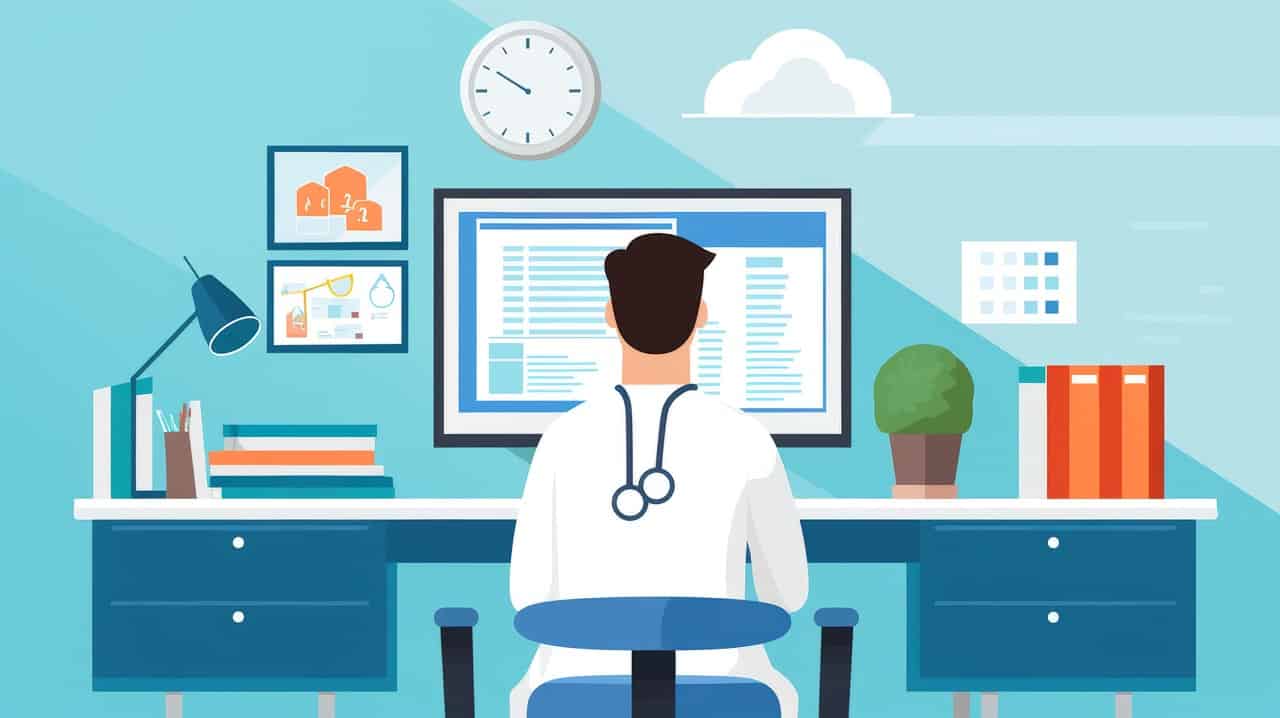Navigating healthcare can feel like a daunting task, can’t it? Like you, we’ve also grappled with the complexities of traditional healthcare systems. Census Bureau data reveals that about 27.5 million Americans didn’t have health insurance at any point in 2018 – an unsettling statistic that signifies accessibility issues.
This is where virtual care steps in as a game-changer. In this blog post, we’ll unravel the world of virtual healthcare and demonstrate how it introduces convenience and streamlines patient-doctor communication without compromising on quality care.
Are you ready to explore the future of health care?
Key Takeaways
Virtual healthcare is a form of remote patient engagement that utilizes technology-enabled healthcare services.
It includes features such as remote monitoring, online consultations and appointments, and the use of digital tools and software.
Telehealth and telemedicine are key components driving virtual healthcare’s success, allowing for real-time communication between patients and healthcare providers from anywhere.
Digital tools such as mobile health apps, electronic health records (EHRs), telehealth platforms, wearable devices, remote monitoring systems, artificial intelligence (AI) algorithms, virtual reality (VR) technology, and patient portals enhance the delivery of virtual healthcare.
Technology enables patients to conveniently access care through phones, tablets, or computers via telehealth apps or online portals provided by healthcare organizations.
Table of Contents
Definition and Overview of Virtual Healthcare

Virtual healthcare is a form of remote patient engagement that utilizes technology-enabled healthcare services, including features such as remote monitoring, online consultations and appointments, and the use of digital tools and software. This is where healthcare consulting services step in as a game-changer.
Remote patient engagement
Diving into the depth of virtual healthcare, one critical component that plays an immense role is remote patient engagement. This feature showcases how technology can strengthen connections between patients and healthcare providers, even from a distance.
It’s not about doctor visits and check-ups only; it transforms the traditional approach moving beyond to include proactive health management. Essentially, in this model, you have access to your personal medical history or current health situation at your fingertips at any time.
You’re able to connect with care teams digitally – through secure messaging channels or video calls – discuss symptoms, and receive professional advice or treatment recommendations all within the comfort of your home, eliminating travel time which could be vital, particularly for those having chronic conditions needing urgent care attention! Consider CMS’s keen interest in remote monitoring as a testament to its significance in modern-day healthcare delivery methods.
Moreover, mobile apps now facilitate setting reminders for medication intake or exercises prescribed by physical therapists – ensuring strict adherence to treatment plans and enhancing the overall quality of patient care, which was considered challenging before virtualization arrived on the scene.
Let me tell you, my geeky friends; it’s also breaking geographic boundaries and extending reach where primary care provision wasn’t possible due to various reasons providing higher accessibility than ever before! The future looks bright here: soon, we might see ‘virtual clinics’ sprouting up catering specifically towards routine check-up purposes freeing up in-person appointments for complex cases requiring more specialized services.
Technology-enabled healthcare services
Embracing the power of technology, virtual healthcare services are here to revolutionize patient care. These services offer a bridge that connects patients with their healthcare professionals without geographical limitations, expanding access to care.
Telehealth or telemedicine is a perfect example. Utilizing telecommunications technologies such as phones, tablets, computers, and even specific mobile apps, allows for medical consultations and treatments remotely.
Let’s delve into more about telemedicine. It enables health-related interactions through video calls or phone appointments between patients and care providers in real-time – synchronous engagement at its finest! Whether you’re managing a chronic condition or need urgent care during the pandemic, telehealth brings professional health advice right at your fingertips.
So essentially, what we have here is an efficient blend of digital health into our existing healthcare system – Increased accessibility and convenience redefined!
How Virtual Healthcare Works

Virtual healthcare works through various methods such as telehealth and telemedicine, online consultations and appointments, and the use of digital tools and software.
Telehealth and telemedicine
Let’s dig deep into the world of telehealth and telemedicine, two key components driving virtual healthcare’s success. Telehealth, in its essence, leverages technology to connect you directly with your healthcare provider from the comfort of your home or wherever you may be.
You can discuss symptoms, medical issues, and more through digital communication tools – think of a FaceTime call with your doctor! Moving onto telemedicine, it unlocks a new level of convenience by enabling video or phone appointments offering flexibility that traditional in-person visits lack.
So instead of taking time off work for minor ailments or routine check-ups, now they happen at your pace, on your schedule. This shift towards remote care unfolded rapidly during the COVID-19 pandemic as a way to avoid physical contact while upholding essential health services.
Not limited just to consultations, though! Telehealth has literally stretched boundaries by providing remote surgeries, too – imagine being operated upon by a surgeon who isn’t even in the same room as you! As we adapt and evolve with these advancements in technology at our fingertips like never before, one thing is crystal clear: this could well become the future face of healthcare delivery.
Online consultations and appointments
I love geeking out about virtual healthcare, especially when it comes to online consultations and appointments! Let’s explore how this aspect of virtual healthcare works:
- Patients can have video or phone appointments with their healthcare providers through telemedicine.
- Telehealth eliminates the need for in-person visits, making it super convenient.
- You can access medical care virtually using your computer, tablet, or smartphone.
- Online consultations provide an alternative to traditional healthcare for various conditions and concerns.
- Through virtual visits, you can consult with doctors, mental health counselors, and nurses.
- Telemedicine has gained popularity during the COVID-19 pandemic as a safe way to receive medical care.
- It allows you to avoid physical contact while still getting the care you need.
- You can receive prescriptions and medical advice through virtual consultations.
- Telehealth technology plays a crucial role in facilitating online appointments and consultations.
- It supports social distancing practices and reduces the risk of spreading infectious diseases.
- Online consultations provide convenience for individuals with mobility issues or limited access to transportation.
- They also enable healthcare providers to reach a broader patient base.
Digital tools and software
Digital tools and software are vital components of virtual healthcare, enabling healthcare professionals to deliver efficient and effective care. As a geek, you’ll be fascinated by the innovative technologies that make virtual healthcare possible. Here are some examples:
- Mobile Health Apps: These smartphone applications allow patients to access medical information, monitor their health conditions, and even communicate with their care providers remotely.
- Electronic Health Records (EHRs): EHRs are digital versions of patients’ medical records that can be securely accessed by healthcare providers to obtain accurate and up-to-date information about a patient’s health history.
- Telehealth Platforms: These platforms serve as secure virtual meeting spaces for doctors and patients to connect through video conferencing or phone calls. They facilitate real-time communication and enable thorough assessments without the need for in-person visits.
- Wearable Devices: These devices, such as smartwatches or fitness trackers, collect data on various health parameters like heart rate, sleep patterns, and physical activity levels. This information can then be shared with healthcare professionals for remote monitoring and improved care management.
- Remote Monitoring Systems: Through sensors and connected devices, remote monitoring systems track patients’ vital signs, symptoms, or medication adherence from a distance. This helps identify any potential issues early on and provides timely interventions.
- Artificial Intelligence (AI) Algorithms: AI-powered algorithms analyze large amounts of medical data to assist in diagnosing diseases or identifying treatment options tailored to individual patients’ needs.
- Virtual Reality (VR) Technology: VR technology is used to simulate real-world scenarios for education, training, and therapy purposes in areas such as mental health or rehabilitation.
- Patient Portals: These online platforms enable patients to securely access their medical records, schedule appointments, request prescription refills, or communicate with their care team conveniently from their own homes.
Accessing care through phones, tablets, or computers
As a geek, you know how important technology is in our everyday lives. When it comes to accessing healthcare, technology has revolutionized the way we receive care. With virtual healthcare, you can conveniently access care through your phones, tablets, or computers. Here’s how:
- Telehealth apps: There are numerous telehealth apps available that allow you to connect with healthcare providers from the comfort of your own device. These apps provide a range of services, including video consultations, medication management, and even remote monitoring for chronic conditions.
- Online portals: Many healthcare organizations now offer online portals where you can securely access your medical records and test results and communicate with your care team. These portals are accessible through web browsers on any internet-enabled device.
- Mobile apps: Some clinics and hospitals have their own mobile apps that provide easy access to healthcare services. These apps often include features like appointment scheduling, prescription refills, and virtual visit options.
- Video conferencing platforms: Virtual visits with healthcare providers can be conducted through popular video conferencing platforms such as Zoom or Microsoft Teams. This allows for face-to-face interactions and real-time communication with your doctor without leaving your home.
- Remote monitoring devices: For individuals with chronic conditions, remote monitoring devices can be used to track vital signs like blood pressure or glucose levels. The data collected by these devices can then be transmitted to your healthcare provider for analysis and adjustments to your treatment plan.
Benefits of Virtual Healthcare
Virtual healthcare offers numerous benefits, including increased accessibility and convenience for patients. Read on to learn how virtual care can improve communication, reduce the need for in-person visits, and enhance the quality of patient care.
Increased accessibility and convenience
As a geek, I know how important accessibility and convenience are in our fast-paced world. That’s why virtual healthcare is such a game-changer. With telemedicine, also known as virtual care, we can get the medical attention we need without leaving the comfort of our homes.
No more sitting in crowded waiting rooms or wasting time traveling to clinics. We can simply use our phones, tablets, or computers to connect with healthcare providers through online consultations and appointments.
It’s not only convenient but also allows us to access care regardless of our location. Plus, the use of technology in telehealth improves communication and information flow between patients and doctors, ensuring that we receive high-quality care efficiently.
Reduced need for in-person visits
Virtual healthcare has significantly reduced the need for in-person visits to doctors’ offices and clinics. With telemedicine and telehealth services, patients can now receive medical care without leaving their homes or workplaces.
This is especially beneficial for individuals living in rural or underserved areas who may have limited access to healthcare facilities. The use of digital tools, such as video consultations and online appointment scheduling, allows patients to connect with their healthcare providers remotely.
One important advantage of reduced in-person visits is the increased convenience it offers. Patients no longer have to spend time traveling long distances or waiting in crowded waiting rooms.
Instead, they can simply log onto a virtual platform from their phones, tablets, or computers and consult with their doctors directly.
Moreover, this shift towards virtual care also minimizes exposure to contagious diseases like COVID-19. By avoiding physical contact during appointments, patients are less likely to come into contact with viruses or bacteria present at medical facilities.
Improved communication and information flow
In the world of virtual healthcare, one of the key benefits is the improved communication and information flow between patients and healthcare providers. With telehealth technology at our fingertips, we can easily connect with our doctors through video or phone appointments.
This means that we can discuss our health concerns, ask questions, and receive expert advice without having to physically visit a clinic or hospital. Moreover, virtual healthcare allows for seamless sharing of medical records and test results electronically, making it easier for doctors to access relevant information and make well-informed decisions about our care.
So whether you’re managing a chronic condition or seeking treatment for a minor ailment, virtual healthcare ensures that communication remains efficient, convenient, and effective in delivering high-quality patient care.
Enhanced patient care quality
In the world of virtual healthcare, one of the biggest advantages is the enhanced quality of patient care. Through telemedicine and digital tools, patients can receive timely and personalized care from healthcare professionals without needing to leave their homes.
This not only improves accessibility and convenience but also allows for more efficient communication and information flow between patients and providers. With remote monitoring capabilities, healthcare professionals are able to track patients’ health conditions closely, providing timely interventions when necessary.
Additionally, virtual healthcare enables collaboration among experts in different locations, resulting in improved overall care quality for patients. It’s a game-changer that brings about better outcomes for individuals, regardless of where they are located or what health challenges they may face.
Frequently Asked Questions About Virtual Healthcare
What is virtual healthcare?
Virtual healthcare, also known as telehealth or telemedicine, refers to the delivery of medical services and consultations remotely using technology such as video calls, phone calls, or online messaging platforms.
How does virtual healthcare work?
In virtual healthcare, patients can communicate with healthcare professionals remotely for diagnoses, treatment plans, prescription refills, and follow-up appointments. This is typically done through secure platforms that protect patient privacy and allow for real-time communication between patients and doctors.
What are the benefits of virtual healthcare?
Virtual healthcare offers several benefits, including convenience, since it eliminates the need for in-person visits to a doctor’s office or hospital. It also provides greater access to medical care for individuals in remote areas or those with mobility limitations. Additionally, virtual healthcare reduces wait times and allows for flexible scheduling.
Are all types of medical conditions suitable for virtual healthcare?
While many routine check-ups and non-emergency conditions can be addressed through virtual healthcare, not all medical conditions may be suitable for remote consultation. Serious health emergencies or situations requiring physical examinations would still require in-person visits to a hospital or clinic. It is best to consult with your primary care physician or specialist to determine if your condition can be managed via virtual means.
Conclusion
In conclusion, virtual healthcare is revolutionizing the way we access and receive medical care. Through telemedicine and online consultations, patients can connect with healthcare providers remotely using digital tools and software.
This not only increases accessibility but also improves communication, enhances patient care quality, and reduces the need for in-person visits. Virtual healthcare is paving the way for a more convenient and efficient future of healthcare delivery.
